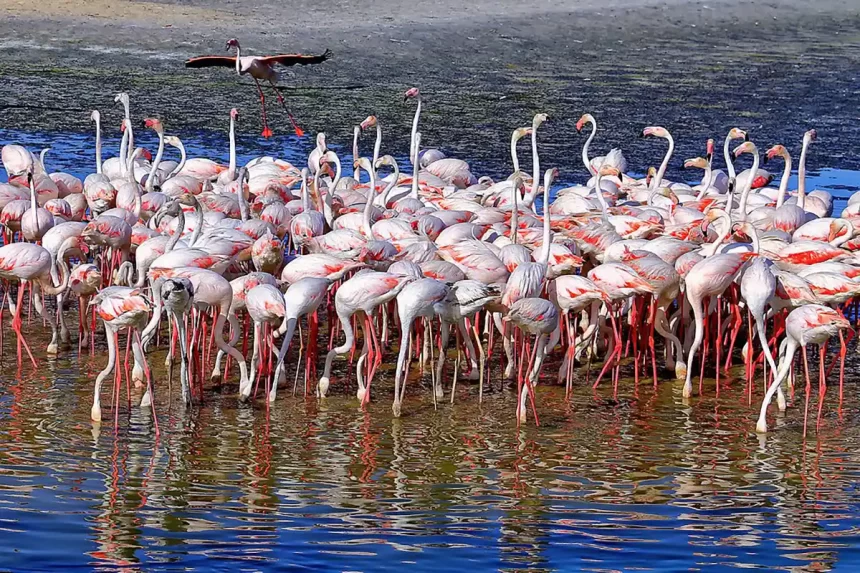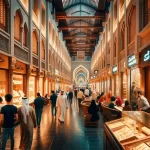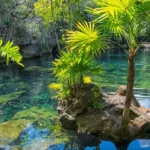Overview of Ras Al Khor Wildlife Sanctuary
Ras Al Khor Wildlife Sanctuary, situated at the southern tip of Dubai Creek in the United Arab Emirates, stands out as a rare urban protected area. This coastal wetland holds significant global importance, making it a haven for wildlife in Dubai amidst the bustling city.
If you have an affinity for avian and animal life, you’ll be delighted to discover a natural refuge in Dubai where your feathered friends can thrive. Ras Al Khor Wildlife Sanctuary provides a natural habitat tailored to their needs, ensuring a healthy environment and access to essential resources for migratory birds that flock to the sanctuary during the winter season.
Referred to as the “Cape of the Creek,” this sanctuary is among the few wetlands in the UAE that boast a diverse range of flora and fauna. Managed by the Dubai Municipality, it epitomizes the perfect ecosystem. Today, we present a comprehensive guide to this serene and tranquil sanctuary in Dubai.
Location and Accessibility of Ras Al Khor Wildlife Sanctuary

Situated at the head of Dubai Creek, the Ras Al Khor Wildlife Sanctuary serves as a haven for the protection, conservation, and preservation of the ecosystem and nature. Its primary objective is to provide a stable environment and meet the needs of the migratory birds that flock here during the winter season.
To reach the sanctuary, you can rent a car from the nearest Metro station. Drive along the Dubai to Hatta motorway (E44) and continue towards Al Ain on E71. Look for signposts indicating Hatta and then turn back to Dubai-Hatta Road towards Dubai. Keep an eye out for the turnoff to the sanctuary from the 4-lane highway along the route and follow it. The sanctuary’s operating hours during the winter season are from 7:30 am to 5:30 pm, and during the summer season (April to September), the timings extend from 6 am to 6 pm.
Unique Attractions of Ras Al Khor Wildlife Sanctuary
Known by its abbreviation RAKWS, Ras Al Khor Sanctuary is a wetland reserve located within the Ras Al Khor community in Dubai. It provides a home to numerous mammals, crustaceans, birds, fish, and reptiles. While the sanctuary is famous for its flamingos, visitors can also catch sight of reef herons, black-winged stilts, ospreys, sandpipers, egrets, kingfishers, black-tailed godwits, Eurasian spoonbills, sand racers, horned vipers, and various other species.
In addition to its diverse fauna, the sanctuary is adorned with a variety of plants that maintain the ecological balance of the area. Common reeds, bean capers, and strings of beads are among the most prominent plant species in this urban wildlife reserve.
Spanning an area of 6.2 square kilometers, enclosed by a buffer zone, the Sanctuary is home to approximately 266 species of fauna and 47 species of flora. Its rich biological diversity stems from the presence of various ecosystems, including mangroves, mudflats, lagoons, sabkhas, reed beds, and shrublands. Amidst this abundance of plant and animal life, the graceful presence of greater flamingos against the backdrop of lush green mangroves stands out as the sanctuary’s most captivating natural feature.
Ras Al Khor Wildlife Sanctuary as Dubai’s Nature Haven
Millions of tourists flock to Dubai each year, drawn by its fabulous attractions. However, not just humans, but also migrating birds find their way to this vibrant city, making it their default winter destination. Nestled just a few kilometers away from the bustling urban landscape lies the breathtaking Ras Al Khor Wildlife Sanctuary, an ancient wetland that serves as a haven for wildlife.
If you have a deep appreciation for nature, Ras Al Khor Wildlife Sanctuary will undoubtedly captivate you. Spanning an area of 620 hectares, this picturesque reserve boasts a diverse ecosystem featuring mangroves, an array of bird species, including around 20,000 individual birds, stunning pink flamingos, small islands, salt flats, and verdant ponds. During the winter season, these wetlands become a platform for migrating birds, providing a delightful spectacle as they establish their temporary territories. Visitors are even given the opportunity to feed the birds during designated times, creating an intimate connection with these magnificent creatures.
This delicate and vast ecosystem serves as an ideal destination for nature lovers, birdwatchers, botanists, environmentalists, and photographers alike. The region’s magnificence extends to its rich flora, which harmoniously complements the diverse fauna, adding to the beauty of this natural reserve. Consequently, Ras Al Khor Wildlife Sanctuary stands out as one of the best-managed sanctuaries in Dubai, a testament to its commitment to preserving and showcasing the wonders of nature.

Best Time to Visit Ras Al Khor Wildlife Sanctuary
The ideal time to visit the sanctuary is during the winter season, which falls between December and March. The weather is cooler during this time, making it comfortable for exploration. It is the prime period to witness migratory birds from African countries as they visit their winter homes. Additionally, this time offers the opportunity to observe the enchanting pink flamingos occupying their designated space in this natural reserve. Flamingos, like humans, form lifelong partnerships, and their bond lasts for decades. Don’t miss the chance to witness these lovely flamingo couples!
Exploring the ‘Cape of the Creek’ at Ras Al Khor
Ras Al Khor is often referred to as the ‘Cape of the Creek’ and stands out as a sanctuary in the UAE that features both flora and fauna. The Dubai Municipality closely monitors and protects this area to safeguard its surroundings. The UAE has successfully established a perfect ecosystem within the sanctuary, allowing visitors to admire the birds in their natural habitat.
The sanctuary encompasses a variety of environments, including saline flats, mudflats, mangroves, and lagoons, providing nesting grounds and habitats for birds. Besides birds, the sanctuary is also home to crustaceans, mammals, reptiles, and fish. Visitors may spot ospreys, kingfishers, sand racers, and many other species. Within the sanctuary, three bird hides are available for tourists to visit freely during opening hours. During the winter season, the sanctuary attracts a larger number of visitors. Entry to Ras Al Khor Sanctuary is free of charge, so you can enjoy the experience without worrying about ticket prices.
Important Information for Visitors to Ras Al Khor Wildlife Sanctuary
When planning your visit to Ras Al Khor Wildlife Sanctuary, there are a few important things to keep in mind. Whether you’re embarking on a solo trip or traveling with a group, you do not require a permit to enter the sanctuary. However, media channels, organized tours, academic institutions, and other organizations must obtain a grant in advance from www.dm.gov.ae. It is recommended to apply at least three days before your visit, allowing the coordinators at least two working days to process your grant. Submit your application to the Marine Environment & Wildlife Section and Dubai Municipality. Once you receive the electronic permit, make sure to print it out and provide a copy to the sanctuary staff upon arrival.
During your visit, it is essential to adhere to certain guidelines. Littering and hunting are strictly prohibited within the wildlife sanctuary. Additionally, please note that pets are not allowed inside the sanctuary premises. For an enhanced bird-watching experience, we recommend bringing your own binoculars.
The Flamingo Hide at Ras Al Khor
The Flamingo Hide offers a great vantage point to observe the flamingoes up close, including the elusive Greater Flamingo. Watch these magnificent birds feed eagerly, as they are cared for by the park rangers in the afternoon. The flamingoes share their habitat with other bird species such as spoonbills, avocets, marsh harriers, ringed plovers, grey herons, and kingfishers. They flock to the ponds to indulge in their delicious feast of milkfish and queenfish in the nutrient-rich waters. As you gaze toward the Zabeel fish lakes, you may also spot Great Spotted Eagles and various raptors soaring overhead.
Notable Wildlife at Ras Al Khor
During your visit, keep an eye out for some remarkable wildlife in Dubai at the sanctuary:
- Ferruginous Duck
- Ethiopian Hedgehog
- Blue Swimming Crab
- Mozambique Tilapia
- Tigerfish
- Blue-Headed Agama
- Fringe-Toed Lizard
- Mangroves
Conservation and Management of Ras Al Khor Wildlife Sanctuary
The Dubai Municipality takes great care in preserving the wildlife and natural environment of the sanctuary. Through proper waste management, constant monitoring, and effective law enforcement, they have successfully ensured the maintenance of water quality, the growth of mangrove saplings, and the well-being of animals in their natural habitat.
Visitor Information for Ras Al Khor Wildlife Sanctuary
- Ras Al Khor Wildlife Sanctuary Tickets: Free of charge.
- Things to Remember: Littering and hunting prohibited, no pets allowed.
- Parking Facility: Dedicated parking area for visitors.
- Location, Timings & Contact: Baniyas 20, Baniyas Road, Deira; Winter (Oct-March): 07:30 am to 05:30 pm, Summer (April-Sept): 06:00 am to 06:00 pm.
Conclusion
Ras Al Khor Wildlife Sanctuary is a breathtaking sanctuary that offers a unique experience of wildlife and nature in the heart of Dubai. It’s an ideal destination for bird enthusiasts and nature lovers.
Reference : Ras Al Khor Wildlife Sanctuary











